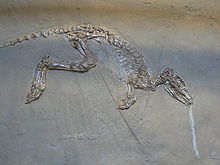Heinz Tobien
Heinz Tobien (born April 8, 1911 in Braunschweig , † March 14, 1993 in Mainz ) was a German paleontologist who was particularly concerned with the mammalian fauna of the Tertiary .
life and work
Tobien studied as a scholarship holder of the German people in Berlin, Munich and Freiburg im Breisgau, where he received his doctorate in palaeontology on Ice Age hares in Sardinia under Wolfgang Soergel in 1935 . After completing his habilitation in Freiburg, he was a soldier on the Eastern Front in World War II. In 1945 he was back at the University of Freiburg, where he became an adjunct professor in 1949. In 1950 he went to the Hessisches Landesmuseum in Darmstadt as head of the geological-paleontological department. In 1956 he became an associate professor and later a full professor at the University of Mainz . In 1963/64 he was visiting professor at the University of California, Berkeley . In 1976 he retired, but remained scientifically active. He lived in Ingelheim am Rhein , where he is also buried.
Tobien dealt with mammals of the tertiary, in particular with rodent teeth and their application in stratigraphy, but also with large mammals up to elephants. He did a lot of digging in the Messel pit in the 1960s .
Among other things, he was the first to describe Leptictidium auderiense (1962) and Sinomastodon intermedius .
In 1985 he became an honorary member of the Paleontological Society , in 1990 the Society of Vertebrate Paleontology and in 1991 an honorary member of the Upper Rhine Geological Association (OGV) . In 1984 he became an honorary member of the Rheinische Naturforschenden Gesellschaft. Since 1981 he was a corresponding member of the Bavarian Academy of Sciences .
Dedication names
In 1980 the Swiss palaeontologist Burkart Engesser described the fossil insect eater Mioechinus tobieni . In 1987 Gerhard Storch and Wighart von Koenigswald named Leptictidium tobieni after Tobien. Hans Hermann Schleich honored him in 1988 with the specific epithet of the fossil double worm Palaeoblanus tobieni . In 2016 the fossil proboscis species Sinomammut tobieni was named in honor of Heinz Tobien.
literature
- K. Rothausen, Obituary in Paläontologische Zeitschrift, Volume 67, 1993, p. 223
Fonts
- The insectivores and rodents from the aquitaine crevices near Tomerdingen (Ulmer Alb). Freiburg: Reports of the Natural Research Society. 1939.
- The Upper Pliocene mammal fauna of Wölfersheim / Wetterau. Journal of the German Geological Society. 1953.
- On the history of equine odd-toed ungulates in Tertiary Europe. Journal of the German Geological Society. 1960.
- Insectivors (Mammalia) from the Middle Eocene (Lutetium) from Messel near Darmstadt. Wiesbaden: Notbl. hess. State Office. Soil Research. 1962.
- Insect feeding traces on tertiary and Pleistocene mammalian bones. Senckenbergiana Lethaea. 1965.
- On the evolution of mastodonts (Proboscidea, Mammalia). Wiesbaden: Hessian State Office for Soil Research. 1973.
- The column fillings of the older Pleistocene from Neuleiningen near Grünstadt (Palatinate) (preliminary communication) (with Franz Malec ). Mainz geoscientific communications. 1976.
- Mammalian fauna from the Pliocene / Pleistocene border in Rheinhessen. 1. The column fillings from Gundersheim near Worms. Mainz geoscientific communications. 1980.
- Taxonomic status of some Cenozoic mammalian faunas from the Mainz Basin. Mainz geoscientific communications. 1980.
- Mastodons (Proboscidea, Mammalia) from the Late Neogene and Early Pleistocene of the People's Republic of China. Part I, Historical Account (with GF Chen, i YQ Li). Mainz geoscientific communications. 1986.
- Northwest Germany in the Tertiary. Berlin: Gebr. Borntraeger. 1986.
- Comments on the age of the Almiocene mammal fauna of Frankfurt / North Basin and the prebasal sediment sequences in the subsoil of Frankfurt am Main. Geological yearbook of Hessen. 1987.
Web links
Individual evidence
- ^ Heinz Tobien obituary in the 1994 yearbook of the Bavarian Academy of Sciences (PDF file).
- ↑ Dimila Mothé, Leonardo S. Avilla, Desi Zhao, Guangpu Xie and Boyang Sun (2016). A new Mammutidae (Proboscidea, Mammalia) from the Late Miocene of Gansu Province, China . Anais da Academia Brasileira de Ciências. Online edition. doi : 10.1590 / 0001-3765201520150261
| personal data | |
|---|---|
| SURNAME | Tobien, Heinz |
| BRIEF DESCRIPTION | German paleontologist |
| DATE OF BIRTH | April 8, 1911 |
| PLACE OF BIRTH | Braunschweig |
| DATE OF DEATH | March 14, 1993 |
| Place of death | Mainz |
